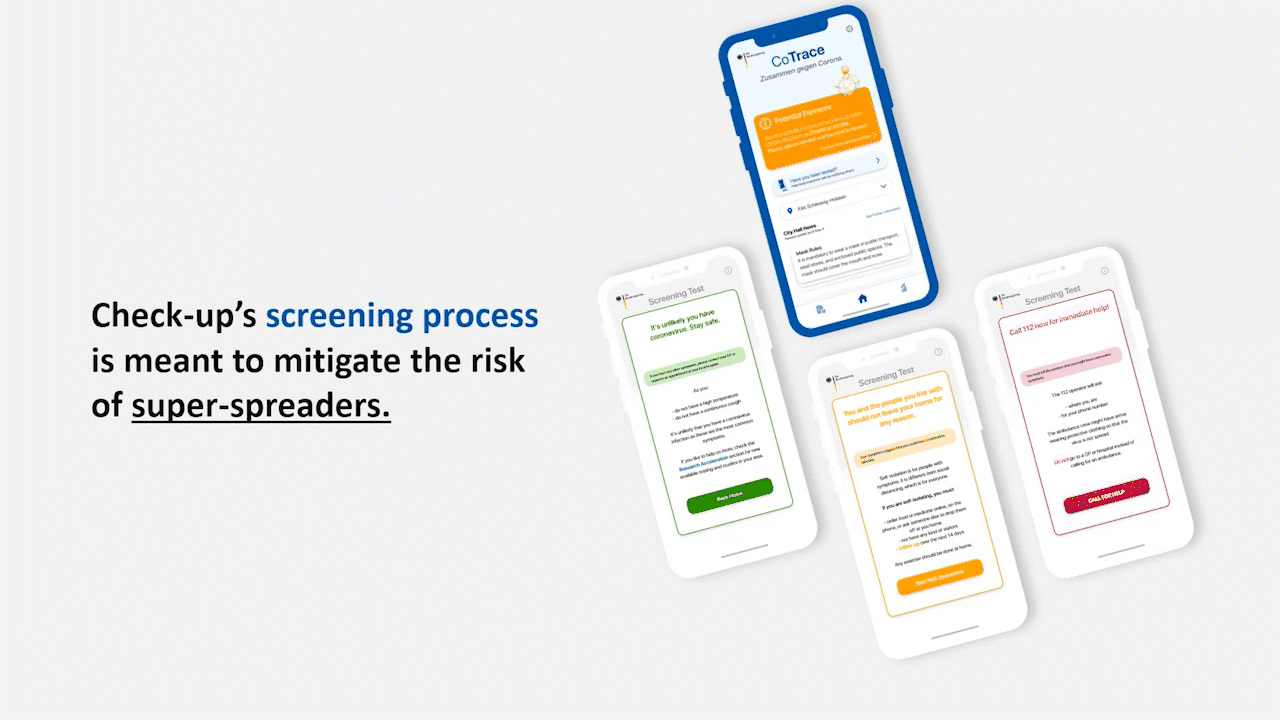
Focus: Initial Pandemic Response | Period: Summer Semester 2020 | Mentor: Prof. Detlef RheinCoTrace is an Advanced Contact Tracing app that differentiates itself with its unique Accessibility Features and Research Acceleration section.
Context
In public health, manual contact tracing is the process of identifying individuals who may have come into contact with an infected person. However, during pandemics such as COVID-19, manual contact tracing couldn't keep up with the exponential infection rate.
Concept
CoTrace is an advanced contact tracing app that uses Apple and Google's secure COVID-19 exposure logging API, which allows it to use low-energy Bluetooth to evaluate the risk of exposure to the virus.
App Overview
The initial idea was to develop and release the app to the market ASAP. However, when the API was made exclusive to government institutions, I pivoted my project to focus on the gaps in contact tracing apps, mainly the lack of accessibility, and the low adoption rate. Nonetheless, the app's base functionality remained intact.
𝗖𝗼𝗧𝗿𝗮𝗰𝗲's base functionality is to automate contact tracing and to notify the user based on the exposure risk evaluation.
The risk evaluation takes into account many variables, including:
⌚ The duration of the contact instance,
📅 The time of the contact as COVID-19 carriers are most contagious after the incubation period,
📱 The distance is based on the strength of the Bluetooth signal.
Furthermore, the home screen contains a news section where all new regulations and announcements regarding COVID-19 are featured.
Graphic Elements
Although persona graphics were a small part of the project, multiple iterations had to be developed to reach a neutral style. The illustrations were designed to provide a subtle human touch while respecting the pandemic's seriousness and the overall uneasiness that comes with it.
Challenge_1
Individuals notified of a potential exposure would rush into hospitals, further increasing the load on health departments and endangering the spread of the infection.
Solution_1
Controlling and mitigating the risk of infection spread by digitally screening each potential patient. Non-critical cases are advised to self-quarantine and to take a daily follow-up test in case any serious symptoms arise.
The 'potential risk notification' prompts the user with a screening test, that could either lead to a lower risk status (e.g., no physical contact because of a wall), or advise the user to self-quarantine (which is followed by a 14-days follow-up procedure), or call for immediate help and PCR testing.
Challenge_2
The risk group (60 years+) makes up around 40% of Germany's population, and they tend to be visually impaired and technologically challenged. Furthermore, language could pose a challenge to Germany's immigrant population, which is around 15%.
Solution_2: Accessible UI
An optional 𝗔𝗰𝗰𝗲𝘀𝘀𝗶𝗯𝗹𝗲 𝗨𝗜 that is designed for the risk group, visually impaired, and specially-abled users as the design is 100% WCAG 2.1 compliant.
Only essential information is displayed, with the option to navigate the app by only using their voice. The app is available in the top 4 languages in Germany; German, English, Turkish, and Arabic.
Users can share their exposure risk status with a guardian/caregiver, which simply stacks under their exposure risk status in the standard UI. With it, families and nursing homes can mitigate the risk of infection by taking appropriate and timely precautions.
Accessible UI only displays the risk of exposure to minimize the user's visual and cognitive load while providing them with the same security.
Challenge_3
Contact tracing apps need a minimum of 60% population adoption to be effective. Meaning the app would have no meaningful impact until that percentage is reached.
Solution_3: Research Acceleration
CoTrace's Research Acceleration helps us fight against COVID-19 below the ideal population adoption percentage by exponentially expanding the reach and scope of current studies and research.
The section allows users to participate and volunteer in anti-body testing and other COVID-19 studies in their area. This feature aims to leverage the enthusiasm of early adopters to help fight against the pandemic.
2 Interfaces, 1 Experience
As it was integral not to fragment the user base of the contact tracing app, it was necessary to keep both versions of the interface as separate options. That way, we can provide a tailored interface for both demographics (the risk group and the non-risk group) while retaining the base functionality and increasing the population adoption rate of the app.
User Journeys
Update
Coronavirus contact-tracing apps aren't yet the 'game changer' authorities hoped they'd be. So far, they've had a limited impact due to the low adoption rate, mistrust in authorities, and overall inaccessibility.
However, that should not take away from the fantastic fact that millions upon millions have downloaded contact tracing apps in their respective countries. Therefore, our approach to fighting COVID-19 has to change based on the data we have so far.
In the case of CoTrace, a separate Accessible UI was designed, and a Research Acceleration section was developed to benefit from the enthusiasm and empathetic nature of early adopters by volunteering and participating in running COVID-19 research and studies.



























